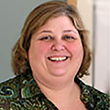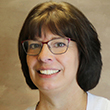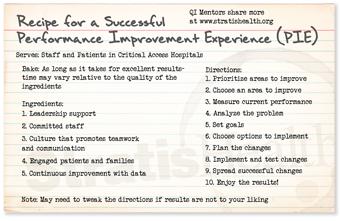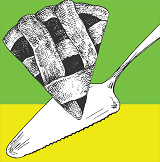“I think the fun and involvement really has to go top-down to the direct caregivers and direct caregivers up to the top. It’s all of us working together to provide that exceptional quality service to our patients in the community.”
August 2021
In this session of Quality Time: Sharing PIE, Mentors Mariah Hesse, BSN, RN, CENP, from Sparrow Clinton Hospital, St. Johns, Michigan, and Brenda Stevenson, RN, from Titusville Area Hospital, Titusville, Pennsylvania, share how they work to make quality improvement (QI) fun and engaging for the staff at their hospitals, including creative ways they’ve found to draw in staff from all levels at their facilities.
Want to take Quality Time with you on the go? You can subscribe to the podcast version through your favorite streaming service.
Resources from your QI Mentors
-
Making QI Fun – themed event examples
-
Making QI Fun – “Big Bang” flu shot poster campaign
-
Making QI Fun – sample scavenger hunt
-
Making QI Fun – example QI pen pal program
Second helping of PIE?
If you would like more information
from the national virtual Quality
Improvement Mentors on their
performance improvement
experience in critical access
hospitals, please submit this
short form.
| QI Mentor favorite featured pie recipe: Rhubarb Strawberry Pie |
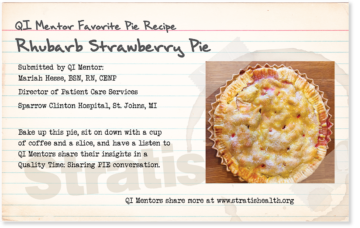 |
Transcript: Making QI Fun
Note: Quality Time: Sharing PIE is produced for the ear and designed to be heard. This transcript is intended to augment the recording.
Narrator: In this episode of Quality Time: Sharing PIE, Brenda Stevenson from Titusville Area Hospital in Titusville, Pennsylvania, and Mariah Hesse from Sparrow Clinton Hospital in St. Johns, Michigan, talk about how they work to make quality fun and engaging for the staff at their hospitals. To start, we asked them to share some creative ways they’ve found to draw in staff on a regular basis from all levels at their facilities.
Brenda: This is Brenda – we do newsletters, we engage all, all the staff. We put bulletin boards up, we go around all three shifts and do fun games, have some prizes and just have a little fun, have no one really being held over the fire for any wrong answers. It’s all about fun and, and just learning, asking questions, and just being engaged.
Mariah: Thanks, Brenda. I think we’re the same here at our facility, if we’re preparing for accreditation meeting or have some quality initiatives that we’re working on, we’ll have games, and, um, you get a treat or a prize, or we also have the treat wagon for recognition for good success. Recently with all the demands of COVID-19, we did some celebrations and staff appreciation. And so we would take the treat wagon around, or have an ice cream bar a day and made sure that all shifts would enjoy that treat.
Mariah: On the treat wagon we have all different kinds of things. So usually it does have to do with food. (laughs) but we also have had lip gloss, I.D. badge holds, for hand hygiene we’ve had hand sanitizer. We have some promotional nail files that are cute with little dogs or cats, (laughs) things like that. So we’ll have other little trinkets as well. And we usually try to have healthier snacks like apples or oranges. Sometimes we’ll have a wheel that they spin the wheel and ask a question. It could be for quality or safety.
Brenda: Mariah, what does your…wagon look like?
Mariah: It’s just a plain fold-up wagon that we had purchased, and we will decorate it with some balloons or streamers or red, white, and blue, uh, colors, depending on what we’re celebrating or what our initiatives are.
Brenda: Okay. I may steal that idea. (laughs)
Narrator: The Mentors shared some examples of fun, targeted engagement strategies that have resulted in measurable improvements.
Brenda: This is Brenda, and for the flu vaccine what we wanted to accomplish was we wanted to increase the number of patients that receive our flu vaccine, or at least who we offered the vaccine to. So we established the baseline which we were at 89%, which was pretty low, especially if we compared ourselves with a benchmark of the state national average here in Pennsylvania. I started a poster program that started to tell a story. And every month I’d change that poster.
So I started with The Big Bang Theory, then I started with Sheldon saying, you know, flu season is coming and he’s spraying all the germs and so it just kind of progressed with his friends ended up getting the flu and he was saying, “I told you if you would’ve gotten the flu vaccine, you wouldn’t have gotten this,” and on and on and on well at the very end, he ended up getting the flu because he didn’t do good hand hygiene and on and on.
So it was a story till the end, and that was a big success – we went up to 95%. So, each year so far, this started about five years ago, I started doing a storyline, so we did Gilligan, we’ve done the Looney Tunes, we’ve done Peanuts. So, and if it changes out every month, it gives the staff something new to look at and to look forward to. And it also reminds them because they’re looking at it and not saying I’ve already seen this it reminds them to do that. And we’ve been very successful. We’ve always been over state and national average on our flu vaccine for our patients.
I think it just kind of brings everybody in together as a team. So it was really fun. And then I gave them all the results. So they knew the progression every month of what was happening. So it was, you know, they knew whether, what, what they were doing was working.
Mariah: I love Brenda’s idea with the sitcoms every year. I think she could put that out on the market. One thing that we had is we were looking at our sepsis bundle and sepsis assessment compliance, and there was an opportunity and we actually formed sepsis champion groups where we had frontline caregivers, frontline staff, um, be champions for their units. And we would have meetings and look at ways for improvement. And one thing that came out of that is we did a sepsis poster presentation contest, and it was open across our hospital for all departments. And then they had a certain amount of time to post their posters or presentations or however they wanted to display it, regarding sepsis.
And then we had some of the executive team members go around and they had criteria and judging, and they judge the poster presentations. So like for our emergency department, they had all of their sepsis bundles and compliance, and they did a poster of the chutes and ladders. Patient access, you wonder registration and patient access. They learned so much about sepsis and time zero and compliance. And it was really around October, so they did a whole witches brew, getting rid of sepsis and they had the old fire pot and just trying to eliminate sepsis.
Our pharmacy, they did stomp out sepsis, and they had these footprints all around with different ways and pathways that you would follow for sepsis. Our physician practice, they did minions and they were all in the lab and looking at how they can eliminate sepsis with the minions. And so then they judged. And then we ended up with two winners and our pharmacy department and our patient access with the witches brew won a pizza party.
And really, what it really got down to is the education and awareness. And as Brenda mentioned, having the rates and the compliance rate out in front and forward, which we communicate on our hospital scorecard, which is transparent for everyone and for all caregivers. So you could actually see the rates. So our three-hour sepsis bundle compliance went from 45% to 78%, which was amazing. And right now our last quarter for 2021, we’re 100%.
Brenda: I think that how you got administration involved is really phenomenal, but having them be the judges, they didn’t even realize they were involved in the project.
Mariah: I think the fun and involvement and quality and safety really has to go top-down to the direct caregivers and direct caregivers up to the top. It’s all of us working together to provide that exceptional quality service to our patients in the community.
Narrator: We asked the Mentors how their facilities leveraged national healthcare observances like healthcare quality week, national patient safety week, or infection prevention week to further engagement among staff.
Brenda: We do quality week. Every day of the week we have fun games that we play, we are all themed. So the first one we had was a carnival, so all the games that we did through the week were carnival-themed. They had Plinko and pull the duck and spin the wheel. And so I went around through all three shifts, we had questions depending on the skill of the staff is the difficulty of the question.
So we did all those different games on different days, we always had some kind of a prize. On Thursday was our big event and it’s an all-day, 12-hour from six to six so you get all your shifts. We had different carnival games that they would play carnival foods. We had volunteers that would help us out. We had a photo booth, all the photos I’m going to plug Shutterfly because you can get free photos from Shutterfly. So that’s what I did. I had doubles printed off and each person that attended got their photo, and then I kept a photo for a book that everybody can review at any given time.
So we, we do that themed every year, the one year was construction. So it was building quality together. One year it was Halloween-themed, spooky. I used Pinterest to get a lot of my ideas. Google Flippity, you can get all kinds of different ways to engage staff. As long as they have a computer you can play interactive games, you can give them progression charts, like how we’re doing. So, you know, use Google, find different things that you think would work around quality.
Mariah: Those are great, great themed ideas, Brenda. We have some themed projects as well for fun. Not so much during quality week, which I don’t know, I might have to take some of those (laughs) ideas from Brenda, but during infection prevention week we’ve done some things like the glow germ and the dark light outside of the cafeteria, just to, for fun, or to go to units and just, uh, talk about hand hygiene. For patient safety week we’ve done word searches, word scrambles, uh, crosswords. And then the last few years we’ve done some open-ended questions, this is just to be for fun and learning, and give some opportunities for the staff to think about.
So last year it was pretty simple, I asked what do you do on a daily basis to keep your patients safe? Can you name two national patient safety goals? And is there a safety concern that you may have? And then anyone that participated was placed in a drawing and won some movie tickets. Very simple. Our safety fair, we usually go a little bit somewhere out and it’s a two-day event, and we are open for all three shifts so we cover the nights, afternoons, and day. And it is usually a themed event. Some of the same themes that Brenda has. We had a carnival theme with door prizes for a little popcorn machine or a cotton candy machine. We’ve done a football theme. It had apple cider and donuts, and then we’ve also done the construction theme. And then also we try to do celebrations. We set goals for falls without injury or total falls on our inpatient unit. If we reach those goals, we have a little celebration. And if we’ve really reached our stretch goal we have a hospital-wide celebration as well. Recently we did a tailgate party, it was a lot of fun.
Mariah: And then one of our celebrations last year for employee recognition for COVID and everything that we had went through, we actually brought in three food trucks, and then we had games set up. And people could come out and just grab a treat and play some games.
Brenda: I really love the tailgate idea, Mariah. We, we do the same, we’ll offer prizes, a traveling trophy, parties. You know, when there’s a competition. I think that really brings out a lot of ambition in a lot of people. We’ve been doing ED CAHPs for a long time and then COVID came, we were in the process of remodeling our emergency room, and just the surveys themselves kind of started to drop off. So it was suggested that we have a little competition. So I came up with a race to 50 and it was, whoever could get 50 surveys completed first would receive a prize and a traveling trophy.
I didn’t just end the competition there. It was okay, so this one reached 50, now there’s going to be pop-up prizes and pop-up competitions that you’re not going to know about.
So that kind of kept them in the back of their mind that they needed to continue doing this and not just do it for the month or two months or however long it took somebody to get to the 50 completed. And I have, I’ve had several pop-ups and it’s not just who has completed the most it might be who offered the most or who got the most recognition from, from the patients. And the prizes that we have are personalized, they’ve been bags with their names on them since it’s nursing, like a stethoscope with their name part as the tubing.
So we went from just doing the 50 in November to 230 recently. So that’s a 460% increase in the surveys.
Mariah: They are competitive in the ED.
Brenda: Mm-hmm (affirmative) mm-hmm (affirmative)
Mariah: We have a trophy for the STEMI, so they take whoever the best time to get a patient from arrival to the cath lab, they get their name on that trophy, (laughs) the group or team that was working. And they’re always looking like, “Oh, did I beat the, did I beat the current winner yet?” But, you know, and that’s for transport, but it’s all, the team effort. So, you know, some they’ll keep those people on that cart and get them transferred to our larger tertiary hospital for those cath labs but they’re always looking to see if they’ve got a better time for that trophy.
Narrator: The mentors shared examples of strategies for encouraging staff recognition, both from patients and from peers.
Mariah: For our staff, we have the Daisy award where you recognize the nursing staff, but we also have a team Daisy as well. So as a team Daisy can be all members of the team, it doesn’t have to be all nurses, but usually, it’s nurse-driven, or nurse-led. So I, actually I have the privilege to be the Daisy coordinator here. (laughs) And so it is one of the best things to read those Daisy nominations and to share those with the team. And we actually do it a little differently. Since we are small, we do have the Daisy award out twice a year. And we actually have a whole little celebration and ceremony (laughs) recognition.
Brenda: As far as staff, we have a quarterly employee of the month. And anybody can nominate any person, any employee, and then they are voted on. And then at the end of the year at our annual Christmas party, we have an employee of the year, and it’s one of the four employees of the quarter.
We also have the speak up award for (laughs) our own speak up award. And so people can nominate anyone that has caught a good catch or someone that spoke up that may have not been easy for them to speak up, and they get a little certificate for speaking up and a speak-up cup, like, a Yeti cup (laughs) that they get for doing something that may not have been easy.
Mariah: And then we also, our nursing quality and education council have been coming up with ways to build morale as well, they’re doing this pen pal, and they’ve opened it up to all units and anybody can sign up for a pen pal and their hopes is that you’ll give little tidbits or recognize them, or share something about yourself with them on a weekly basis, and then at the end, you can guess who your pen pal was.
And then they have also made these little thank you postcards, and where anyone can fill them out. And they actually designed it. And it says, thank you for being there for me and they’re little cards that they’ve got on different units, and you can drop them in a box, and then they recognize and hand-deliver that to whoever you recognized.
Narrator: Finally, the Mentors shared the impact their efforts have had on staff morale and buy-in to broader quality activities.
Brenda: I think just in general them recognizing quality and that there is a quality team and that we really are active and it’s just not, frontline staff doing all the work, they realize that there are people behind the scenes that are looking at what the public is seeing and trying to correct anything that may be just going astray and keeping us on track. Our hospital recently was CMS five star. And, you know, I may have been the one as far as being the quality director, but they are the frontline staff, not just nursing, the entire hospital is the one who has made us a five-star hospital. And I let them know it. It’s humbling to know that the staff really are taking quality and it’s, they’re not just coming in to do a job they are coming in to really care for our patients. And it really shows.
Mariah: I could echo the same regarding how proud I am of our staff here as well. We are a work family and truly want to deliver that quality, compassionate care. So when you actually share the stories you know, we start a lot of our meetings with either a safety moment and sometimes a healing moment, but when you share those moments of opportunities or of success, or when you hear a patient give their story at a board meeting and you share that with your staff, that’s what really, I think, motivates people to continue to do the things they do every day. And that’s what we’re all here for, to make sure that we can serve our community and meet their expectations and even exceed expectations in all realms.
Narrator: To see examples of some of the ideas the Mentors shared in this episode, visit the Quality Time: Sharing PIE page at stratishealth.org.
Narrator: Quality Time: Sharing PIE was produced by Stratis Health, with funding through Rural Quality Improvement Technical Assistance — a program supported by the Federal Office of Rural Health Policy — to help critical access hospitals across the country move from quality reporting to quality improvement. Want another serving of PIE? Or have a burning question about rural quality improvement? Visit the QI mentors web page.

